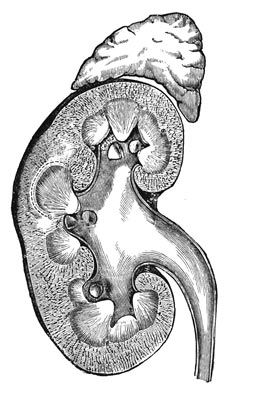… was a pioneer for transplant surgery

Picture: Kidney in cross-section with adrenal gland at the top.
Prof. Joseph E. Murray – The plastic surgeon with the Nobel Prize.
He received this award together with E. Donnall Thomas in the field of physiology or medicine in 1990 for their achievements in organ and cell transplantation in the treatment of human diseases. Joseph Murray performed the first successful human kidney transplant in Boston (USA) in 1954.
Childhood
Joseph Edward Murray was born on 01.04.1919 in Milford (Massachusetts, USA) and died of a stroke in Boston on 26.11.2012 at the age of 93.
His father William A. Murray was a lawyer, his mother Mary DePasquale was a school teacher. In his autobiography, J. Murray writes that he wanted to be a surgeon from an early age. According to Murray, this was certainly due to the good influence of the family doctor who treated his children’s illnesses.
School, college, university
In high school, Murray stood out as an excellent athlete. He achieved his best performances in ice hockey and baseball. After graduating from high school, he entered the College of the Holy Cross in Worcester (Massachusetts). He then began his medical studies at Harvard Medical School, the elite medical university.
In his autobiography 4, Murray says of his time at Harvard that it was like his dreams: heaven on earth. Although he spent a lot of time studying, he enjoyed the proximity of the concert hall, the Gardener Museum, squash, cycling and dancing.
Towards the end of his studies, he met Bobby Link, whom he married in 1945. They had three boys and three girls.
Army, start of career
After graduating from high school, Joseph Murray joined the US Army. He received his surgical training at Valley Forge General Hospital, a military hospital in Pennsylvania. Valley Forge General Hospital was a major center for plastic surgery. Here Joseph Murray spent not only his working hours but all his available free time gaining experience in reconstructive plastic surgery. The head of plastic surgery, Colonel James Barrett Brown, was aware of his commitment. He kept him in his clinic so that he was not sent overseas. Joseph Murray had his first encounters with transplant surgery during this time while treating many burn patients. Initially, skin grafts from other people were used to temporarily cover defects. Joseph Murray was fascinated by the question of why his own body was able to distinguish his own skin from other people’s skin and this was the beginning of his interest in transplant surgery.
Kidney transplant
The first dialysis machine was introduced by Dr. Thorn after the Second World War. With Dr. Wilhelm Kolff and Dr. Carl W. Walter, it was further developed into the artificial kidney (Kolf-Brigham) and used on humans for the first time in 1948. However, the effect of the artificial kidney was only of a temporary nature, so it was obvious that a better and permanent solution had to be found. Joseph Murray found this solution in transplant surgery.
It was already known from skin transplants that there was no rejection reaction in genetically identical twins 1. Together with this knowledge, the progress of vascular and microsurgery and successes in animal experiments, the first kidney transplant was soon to follow. This was carried out by Joseph Murray in 1954 between two identical, i.e. genetically identical, twins 2. Therefore, no immunosuppression (suppression of the immune defense by means of drugs) was necessary for this transplantation.
The first successful kidney transplant on genetically non-identical people was in 1962 3. This was made possible by the advent of immunosuppressive drugs (including azathioprine).
Other organs
With these interventions, organ transplantation took its course. This was followed by liver, heart, lung and other transplants by various research groups. However, survival rates were poor until the end of the 1960s. Only later were survival rates significantly improved by newer drugs.
Closing words
With his research and interventions, plastic surgeon Joseph Murray paved the way not only for kidney transplant surgery, but for transplant surgery in general. The Nobel Prize honors his life’s work.

